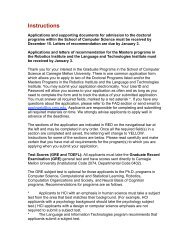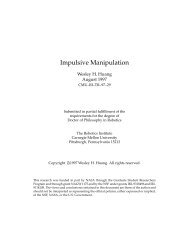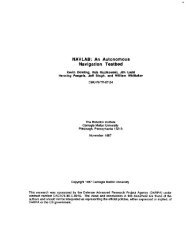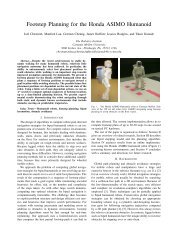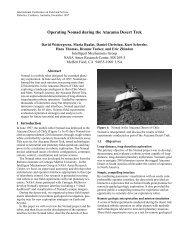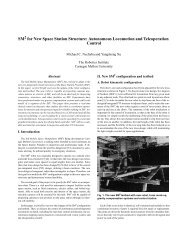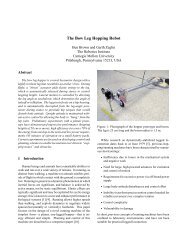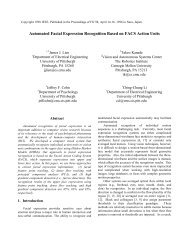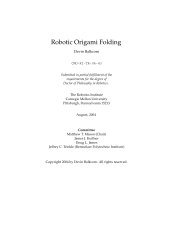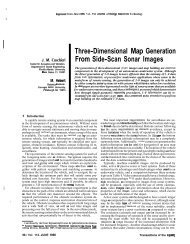Dialogue Processing in a Conversational Speech ... - CiteSeerX
Dialogue Processing in a Conversational Speech ... - CiteSeerX
Dialogue Processing in a Conversational Speech ... - CiteSeerX
You also want an ePaper? Increase the reach of your titles
YUMPU automatically turns print PDFs into web optimized ePapers that Google loves.
<strong>Dialogue</strong> <strong>Process<strong>in</strong>g</strong> <strong>in</strong> a <strong>Conversational</strong> <strong>Speech</strong> Translation System<br />
Alon Lavie, Lori Lev<strong>in</strong>, Yan Qu, Alex Waibel, Donna Gates<br />
Marsal Gavaldà, Laura Mayfield, and Maite Taboada<br />
Center for Mach<strong>in</strong>e Translation<br />
Carnegie Mellon University<br />
5000 Forbes Ave., Pittsburgh, PA 15213<br />
email : lavie@cs.cmu.edu<br />
ABSTRACT<br />
Attempts at discourse process<strong>in</strong>g of spontaneously spoken dialogue<br />
face several difficulties: multiple hypotheses that result from the<br />
parser’s attempts to make sense of the output from the speech recognizer,<br />
ambiguity that results from segmentation of multi-sentence<br />
utterances, and cumulative error — errors <strong>in</strong> the discourse context<br />
which cause further errors when subsequent sentences are processed.<br />
In this paper we will describe our robust parsers, our procedures<br />
for segment<strong>in</strong>g long utterances, and two approaches to discourse<br />
process<strong>in</strong>g that attempt to deal with ambiguity and cumulative<br />
error.<br />
1. Introduction<br />
In this paper we describe how the JANUS [10] multi-l<strong>in</strong>gual speechto-speech<br />
translation system addresses problems that arise <strong>in</strong> discourse<br />
process<strong>in</strong>g of spontaneous speech. The analysis of spoken<br />
dialogues requires discourse processors that can deal with ambiguity<br />
and cumulative error – errors <strong>in</strong> the discourse context which<br />
cause further errors when subsequent sentences are processed.<br />
The <strong>in</strong>put to our discourse process<strong>in</strong>g module is a set of <strong>in</strong>terl<strong>in</strong>gua<br />
texts (ILTs) which are output by the parser. In an attempt to<br />
achieve both robustness and translation accuracy when faced with<br />
speech disfluencies and recognition errors, we use two different<br />
pars<strong>in</strong>g strategies: the GLR* parser designed to be more accurate,<br />
and the Phoenix parser designed to be more robust. For both parsers,<br />
segmentation <strong>in</strong>to units of coherent mean<strong>in</strong>g is achieved <strong>in</strong> a twostage<br />
process, partly prior to and partly dur<strong>in</strong>g pars<strong>in</strong>g. The parsers<br />
are described <strong>in</strong> Section 2 and the segmentation procedures are described<strong>in</strong>Section3.<br />
We have also experimented with two approaches to discourse process<strong>in</strong>g:<br />
a plan <strong>in</strong>ference approach, designed to keep a detailed<br />
representation of the discourse context, and a f<strong>in</strong>ite state processor<br />
augmented with a statistical component, designed to be fast. Both<br />
discourse processors are robust over spontaneous speech. The plan<br />
<strong>in</strong>ference system uses graded constra<strong>in</strong>ts to assign penalties <strong>in</strong>stead<br />
of fail<strong>in</strong>g on unexpected <strong>in</strong>put. The f<strong>in</strong>ite state approach <strong>in</strong>corporates<br />
a solution to the cumulative error problem. The discourse processors<br />
and an evaluation of their performance <strong>in</strong> assign<strong>in</strong>g speech<br />
acts are presented <strong>in</strong> Section 4. Much of our current research deals<br />
((frame *free)<br />
(who ((frame *i)))<br />
(when ((frame *simple-time)<br />
(day-of-week wednesday)<br />
(time-of-day morn<strong>in</strong>g)))<br />
(a-speech-act (*multiple* *suggest *accept))<br />
(sentence-type *state)))<br />
Sentence: I could do it Wednesday morn<strong>in</strong>g too.<br />
Figure 1: An Example ILT<br />
with comb<strong>in</strong><strong>in</strong>g the discourse processors with the other translation<br />
components <strong>in</strong> a way that achieves optimal performance. This is<br />
described <strong>in</strong> Section 4.1.<br />
2. The Robust GLR and Phoenix Translation<br />
Modules<br />
JANUS employs two robust translation modules with complementary<br />
strengths. The GLR module gives more complete and accurate<br />
translations whereas the Phoenix module is more robust over the<br />
disfluencies of spoken language. The two modules can run separately<br />
or can be comb<strong>in</strong>ed to ga<strong>in</strong> the strengths of both.<br />
The GLR module is composed of the GLR* parser [2][3], the LA-<br />
Morph morphological analyzer and the GenKit generator. The<br />
GLR* parser is based on Tomita’s Generalized LR pars<strong>in</strong>g algorithm<br />
[8]. GLR* skips parts of the utterance that it cannot <strong>in</strong>corporate<br />
<strong>in</strong>to a well-formed sentence structure. Thus, it is wellsuited<br />
to doma<strong>in</strong>s <strong>in</strong> which non-grammaticality is common. The<br />
parser conducts a search for the maximal subset of the orig<strong>in</strong>al <strong>in</strong>put<br />
that is covered by the grammar. JANUS GLR grammars are<br />
designed to produce feature structures that correspond to a framebased<br />
language-<strong>in</strong>dependent representation of the mean<strong>in</strong>g of the<br />
<strong>in</strong>put utterance. For a given <strong>in</strong>put utterance, the parser produces a<br />
set of <strong>in</strong>terl<strong>in</strong>gua texts, or ILTs. An example of an ILT is shown<br />
<strong>in</strong> Figure 1. The GLR* parser also <strong>in</strong>cludes several tools designed<br />
to address the difficulties of pars<strong>in</strong>g spontaneous speech, <strong>in</strong>clud<strong>in</strong>g<br />
a statistical disambiguation module, a self-judg<strong>in</strong>g parse quality<br />
heuristic, and the ability to segment multi-sentence utterances.<br />
The JANUS Phoenix translation module [4] is an extension of the<br />
Phoenix Spoken Language System [9]. It consists of a pars<strong>in</strong>g mod-
Orig<strong>in</strong>al utterance:<br />
SÍ QUÉ TE PARECE TENGO EL MARTES DIECIOCHO Y EL MIÉRCOLES<br />
DIECINUEVE LIBRES TODO EL DÍA PODRÍAMOS IR DE MATINÉ O<br />
SEA EN LA TARDE VER EL LA PELÍCULA<br />
(Roughly “Yes what do you th<strong>in</strong>k I have Tuesday the eighteenth and Wednesday the<br />
n<strong>in</strong>eteenth free all day we could go see the mat<strong>in</strong>ée so <strong>in</strong> the afternoon see the the<br />
movie.”)<br />
As decoded by the recognizer:<br />
%NOISE% SI1 QUE1 TE PARECE %NOISE% TENGO EL MARTES<br />
DIECIOCHO Y EL MIE1RCOLES DIECINUEVE LIBRES TODO EL DI1A<br />
PODRI1AMOS IR DE MATINE1 %NOISE% O SEA LA TARDE A VER LA<br />
Parsed:<br />
% si1 que1 te parece tengo el martes dieciocho y el<br />
mie1rcoles diec<strong>in</strong>ueve libres todo el di1a podri1amos *IR<br />
*DE -MATINE1 o sea la tarde a ver LA %<br />
Parse Tree ( Semantic Representation):<br />
[respond] ( [yes] ( SI1 ))<br />
[your_turn] ( QUE1 TE PARECE )<br />
[give_<strong>in</strong>fo] ( [my_availability] ( TENGO [temp_loc]<br />
( [temporal] ( [po<strong>in</strong>t] ( [date] ( EL [d_o_w] ( MARTES ))<br />
[date] ( [day_ord] ( DIECIOCHO ) [conj] ( Y ) EL [d_o_w]<br />
( MIE1RCOLES )) [date] ( [day_ord] ( DIECINUEVE )))))<br />
LIBRES ))<br />
[give_<strong>in</strong>fo] ( [my_availability] ( [temp_loc]<br />
( [temporal] ( [range] ( [entire] ( TODO )EL [unit]<br />
( [t_unit] ( DI1A )))))PODRI1AMOS ))<br />
[suggest] ( [suggest_meet<strong>in</strong>g] ( [temp_loc] ( [temporal]<br />
( O SEA [po<strong>in</strong>t] ( LA [t_o_d] ( TARDE ))))A VER ))<br />
Generated:<br />
English = <br />
Figure 2: A Phoenix Spanish-to-English Translation Example<br />
ule and a generation module. Unlike the GLR method which attempts<br />
to construct a detailed ILT for a given <strong>in</strong>put utterance, the<br />
Phoenix approach attempts to only identify the key semantic concepts<br />
represented <strong>in</strong> the utterance and their underly<strong>in</strong>g structure. It<br />
allows the ungrammaticalities that often occur between phrases to<br />
be ignored and reflects the fact that syntactically <strong>in</strong>correct spontaneous<br />
speech is often semantically well-formed. An example of output<br />
from the Phoenix parser is shown <strong>in</strong> Figure 2. The parsed speech<br />
recognizer output is shown with unknown (-) and unexpected (*)<br />
words marked. These segments were ignored by the parser.<br />
The Phoenix pars<strong>in</strong>g grammar specifies patterns which represent<br />
concepts <strong>in</strong> the doma<strong>in</strong>. Each concept, irrespective of its level <strong>in</strong> the<br />
hierarchy, is represented by a separate grammar file. These grammars<br />
are compiled <strong>in</strong>to Recursive Transition Networks (RTNs). The<br />
parser matches as much of the <strong>in</strong>put utterance as it can to the patterns<br />
specified by the RTNs. The parser can ignore any number<br />
of words <strong>in</strong> between top-level concepts, handl<strong>in</strong>g out-of-doma<strong>in</strong> or<br />
otherwise unexpected <strong>in</strong>put. The parser has no restrictions on the<br />
order <strong>in</strong> which slots can occur. This may add to the ambiguity <strong>in</strong><br />
the segmentation of the utterance <strong>in</strong>to concepts. The parser uses a<br />
disambiguation algorithm that attempts to cover the largest number<br />
of words us<strong>in</strong>g the smallest number of concepts. The result is a<br />
mean<strong>in</strong>gful but somewhat telegraphic translation.<br />
Although both GLR* and Phoenix were specifically designed to<br />
deal with spontaneous speech, each of the approaches has some<br />
clear strengths and weaknesses. Because each of the two translation<br />
methods appears to perform better on different types of utterances,<br />
they may hopefully be comb<strong>in</strong>ed <strong>in</strong> a way that takes advantage of<br />
the strengths of each of them. One strategy that we have <strong>in</strong>vestigated<br />
is to use the Phoenix module as a back-up to the GLR module.<br />
The parse result of GLR* is translated whenever it is judged by<br />
a parse quality heuristic to be “Good”. Whenever the parse result<br />
from GLR* is judged as “Bad”, the translation is generated from<br />
the correspond<strong>in</strong>g output of the Phoenix parser. Results of us<strong>in</strong>g<br />
this comb<strong>in</strong>ation scheme are presented <strong>in</strong> Section 4.2. We are <strong>in</strong><br />
the process of <strong>in</strong>vestigat<strong>in</strong>g some more sophisticated methods for<br />
comb<strong>in</strong><strong>in</strong>g the two translation approaches.<br />
3. Segmentation<br />
Spoken utterances are often composed of several sentences and/or<br />
fragments. Our <strong>in</strong>terl<strong>in</strong>gual approach to translation requires that<br />
utterances be broken down <strong>in</strong>to units of coherent mean<strong>in</strong>g or discourse<br />
function. We call these units Semantic <strong>Dialogue</strong> Units<br />
(SDUs). Utterance segmentation <strong>in</strong> our system is a two stage process.<br />
In the first stage, the utterance is broken down <strong>in</strong>to smaller<br />
segments or “chunks” based on acoustic, statistical and lexical cues.<br />
The smaller segments are then passed on to the parsers, which further<br />
segment them <strong>in</strong>to SDUs us<strong>in</strong>g their own <strong>in</strong>ternal criteria.<br />
The acoustic cues we use <strong>in</strong> the pre-pars<strong>in</strong>g segmentation procedure<br />
<strong>in</strong>clude silence <strong>in</strong>formation and human and non-human noises<br />
which we have found to be <strong>in</strong>dicative of some SDU boundaries. The<br />
statistical component of the segmentation procedure is a confidence<br />
measure that attempts to capture the likelihood of a SDU boundary<br />
between any pair of words <strong>in</strong> the utterance. Assume these words<br />
are [w 1w 2 w 3w 4 ], where the potential SDU boundary be<strong>in</strong>g considered<br />
is between w 2 and w 3. The likelihood of an SDU boundary<br />
at this po<strong>in</strong>t is determ<strong>in</strong>ed us<strong>in</strong>g an estimated probability that is<br />
based on a comb<strong>in</strong>ation of three bigram frequencies: F ([w 1w 2]),<br />
F ([w 2 w 3 ]) and F ([w 3w 4 ]), represent<strong>in</strong>g the frequency of an<br />
SDU boundary occur<strong>in</strong>g to the right, <strong>in</strong> between, or to the left of<br />
the appropriate bigram. Breaks are predicted at po<strong>in</strong>ts where the<br />
estimated probability exceeds a threshold that was arrived at experimentally.<br />
The third component of the pre-pars<strong>in</strong>g segmentation<br />
procedure is a set of lexical cues. These cues are languageand<br />
doma<strong>in</strong>-specific words or phrases that have been determ<strong>in</strong>ed<br />
through l<strong>in</strong>guistic analysis to have a very high likelihood of preced<strong>in</strong>g<br />
or follow<strong>in</strong>g an SDU boundary. These phrases alone do not<br />
trigger SDU boundary breaks. They are comb<strong>in</strong>ed with the statistical<br />
component. The occurrence of a lexical cue triggers a “boost”<br />
<strong>in</strong>crement to the probability of an SDU boundary, as determ<strong>in</strong>ed by<br />
the statistical component.<br />
4. Discourse <strong>Process<strong>in</strong>g</strong><br />
The discourse process<strong>in</strong>g module <strong>in</strong> Janus disambiguates the speech<br />
act of each SDU, updates a dynamic memory of schedules, and <strong>in</strong>corporates<br />
the SDU <strong>in</strong>to discourse context. We have experimented<br />
with two approaches to discourse process<strong>in</strong>g: a plan <strong>in</strong>ference system(basedonworkbyLambert[1])andaf<strong>in</strong>itestateprocessor
Unsegmented <strong>Speech</strong> Recognition:<br />
(%noise% si1 mira toda la man5ana estoy disponible<br />
%noise% %noise% y tambie1n el f<strong>in</strong> de semana si podri1a<br />
hacer mejor un di1a f<strong>in</strong> de semana porque justo el once<br />
no puedo me es imposible va a poder f<strong>in</strong> de semana)<br />
Pre-broken <strong>Speech</strong> Recognition:<br />
(si1)<br />
(mira toda la man5ana estoy disponible %noise% %noise%<br />
y tambie1n el f<strong>in</strong> de semana)<br />
(si podri1a hacer mejor un di1a f<strong>in</strong> de semana)<br />
(porque justo el once no puedo me es imposible va a<br />
poder f<strong>in</strong> de semana)<br />
Parser SDU Segmentation (of Pre-broken Input):<br />
(((si1))<br />
((mira) (toda la man5ana estoy disponible) (y tambie1n)<br />
(el f<strong>in</strong> de semana))<br />
((si podri1a hacer mejor un di1a f<strong>in</strong> de semana))<br />
((porque el once no puedo) (me es imposible)<br />
(va a poder f<strong>in</strong> de semana)))<br />
Translation:<br />
"yes --- Look all morn<strong>in</strong>g is good for me -- and also<br />
-- the weekend --- If a day weekend is better ---<br />
because on the eleventh I can’t meet --<br />
That is bad for me can meet on weekend"<br />
Figure 3: Segmentation of a Spanish Full Utterance<br />
augmented with a statistical component. The plan-based approach<br />
handles knowledge-<strong>in</strong>tensive tasks, exploit<strong>in</strong>g various knowledge<br />
sources. The f<strong>in</strong>ite state approach provides a fast and efficient alternative<br />
to the more time-consum<strong>in</strong>g plan-based approach. Currently,<br />
the two discourse processors are used separately. We <strong>in</strong>tend to comb<strong>in</strong>e<br />
these two approaches with a layered architecture, similar to the<br />
one proposed for Verbmobil [6], <strong>in</strong> which the f<strong>in</strong>ite state mach<strong>in</strong>e<br />
would constitute a lower layer provid<strong>in</strong>g an efficient way of recogniz<strong>in</strong>g<br />
speech acts, while the plan-based discourse processor, at<br />
a higher layer, would be used to handle more knowledge-<strong>in</strong>tensive<br />
processes, such as recogniz<strong>in</strong>g doubt or clarification sub-dialogues<br />
and robust ellipsis resolution. The performance of each approach <strong>in</strong><br />
assign<strong>in</strong>g speech acts is presented <strong>in</strong> Section 4.2.<br />
The plan-based discourse processor [7] takes as its <strong>in</strong>put the best<br />
parse returned by the parser. The discourse context is represented<br />
as a plan tree. The ma<strong>in</strong> task of the discourse processor is to relate<br />
the <strong>in</strong>put to the context, or the plan tree. In general, plan <strong>in</strong>ference<br />
starts from the surface forms of sentences from which speech<br />
acts are then <strong>in</strong>ferred. Multiple speech acts can be <strong>in</strong>ferred for one<br />
ILT. A separate <strong>in</strong>ference cha<strong>in</strong> is created for each potential speech<br />
act performed by the associated ILT. Preferences for pick<strong>in</strong>g one<br />
<strong>in</strong>ference cha<strong>in</strong> over another were determ<strong>in</strong>ed by a set of focus<strong>in</strong>g<br />
heuristics, which provide ordered expectations of discourse actions<br />
given the exist<strong>in</strong>g plan tree. The speech act is recognized <strong>in</strong> the<br />
course of determ<strong>in</strong><strong>in</strong>g how the <strong>in</strong>ference cha<strong>in</strong> attaches to the plan<br />
tree.<br />
the predicted speech act follows idealized dialogue act sequences.<br />
The states <strong>in</strong> the FSM represent speech acts <strong>in</strong> the doma<strong>in</strong>. The<br />
transitions between states record turn-tak<strong>in</strong>g <strong>in</strong>formation. Given<br />
the current state, multiple follow<strong>in</strong>g speech acts are possible. The<br />
statistical component (consist<strong>in</strong>g of speech act n-grams) is used to<br />
provide ranked predictions for the follow<strong>in</strong>g speech acts.<br />
One novel feature of the f<strong>in</strong>ite state approach is that we <strong>in</strong>corporate<br />
a solution to the cumulative error problem. Cumulative error<br />
is <strong>in</strong>troduced when an <strong>in</strong>correct hypothesis is chosen and <strong>in</strong>corporated<br />
<strong>in</strong>to the context, thus provid<strong>in</strong>g an <strong>in</strong>accurate context from<br />
which subsequent context-based predictions are made. It is especially<br />
a problem <strong>in</strong> spontaneous speech systems where unexpected<br />
<strong>in</strong>put, out-of-doma<strong>in</strong> utterances and miss<strong>in</strong>g <strong>in</strong>formation are hard<br />
to fit <strong>in</strong>to the standard structure of the contextual model. To reduce<br />
cumulative error, we focus on <strong>in</strong>stances of conflict between the predictions<br />
of the FSM and the grammar. Our experiments show that<br />
<strong>in</strong> the case of a prediction conflict between the grammar and the<br />
FSM, <strong>in</strong>stead of bl<strong>in</strong>dly trust<strong>in</strong>g the predictions from the dialogue<br />
context, trust<strong>in</strong>g the non-context-based grammar predictions gives<br />
better performance <strong>in</strong> assign<strong>in</strong>g speech acts. This corresponds to<br />
a jump from one state to another <strong>in</strong> the f<strong>in</strong>ite state mach<strong>in</strong>e. Section<br />
4.2 reports the performance of the FSM with jumps determ<strong>in</strong>ed<br />
by the non-context-based predictions of the grammar.<br />
4.1. Late Stage Disambiguation<br />
The robust pars<strong>in</strong>g components discussed <strong>in</strong> Section 2 employ a<br />
large flexible grammar to handle such features of spoken language<br />
as speech disfluencies, speech recognition errors, and the lack of<br />
clearly marked sentence boundaries. This is necessary to ensure<br />
the robustness and flexibility of the parser. However, as a sideeffect,<br />
the number of ambiguities <strong>in</strong>creases. An important feature<br />
of our approach to reduc<strong>in</strong>g parse ambiguity is to allow multiple<br />
hypotheses to be processed through the system, and to use context<br />
to disambiguate between alternatives <strong>in</strong> the f<strong>in</strong>al stages of the process<strong>in</strong>g,<br />
where knowledge can be exploited to the fullest. Local<br />
utterance-level predictions are generated by the parser. The larger<br />
discourse context is processed and ma<strong>in</strong>ta<strong>in</strong>ed by the discourse process<strong>in</strong>g<br />
component, which has been extended to produce contextbased<br />
predictions for resolv<strong>in</strong>g ambiguity. The predictions from<br />
the context-based discourse process<strong>in</strong>g approach and those from the<br />
non-context-based parser approach are comb<strong>in</strong>ed <strong>in</strong> the f<strong>in</strong>al stage<br />
of process<strong>in</strong>g.<br />
We experimented with two methods of automatically learn<strong>in</strong>g functions<br />
for comb<strong>in</strong><strong>in</strong>g the context-based and non-context-based scores<br />
for disambiguation, namely a genetic programm<strong>in</strong>g approach and a<br />
neural net approach. While we were able, <strong>in</strong> the absence of cumulative<br />
error, to get an improvement of both comb<strong>in</strong>ation techniques<br />
over the parser’s non-context-based statistical disambiguation technique,<br />
<strong>in</strong> the face of cumulative error, the performance decreased<br />
significantly. We are <strong>in</strong> the process of <strong>in</strong>corporat<strong>in</strong>g our cumulative<br />
error reduction technique <strong>in</strong> the task of disambiguation.<br />
The f<strong>in</strong>ite state mach<strong>in</strong>e (FSM) discourse processor [5] describes<br />
representative sequences of speech acts <strong>in</strong> the schedul<strong>in</strong>g doma<strong>in</strong>.<br />
It is used to record the standard dialogue flow and to check whether
Approaches<br />
Per cent correct<br />
RandomfromGrammar 38.6%<br />
FSM Strict Context 52.4%<br />
FSM Jump<strong>in</strong>g Context 55.2%<br />
Plan-Based DP 53.8%<br />
Table 1: Approaches to <strong>Speech</strong> Act Assignment<br />
4.2. Evaluation<br />
The results <strong>in</strong> Table 1 show the the performance of the two discourse<br />
process<strong>in</strong>g approaches, namely the plan-based approach and<br />
the f<strong>in</strong>ite state mach<strong>in</strong>e approach for the task of assign<strong>in</strong>g speech<br />
acts. The FSM processor with the cumulative error reduction mechanism<br />
is marked by FSM Jump<strong>in</strong>g Context, and the FSM without<br />
jump<strong>in</strong>g is marked by FSM Strict Context. The choice of randomly<br />
select<strong>in</strong>g a speech act from the non-context-based predictions of the<br />
grammar <strong>in</strong>dicates the performance of the system when we do not<br />
use any contextual <strong>in</strong>formation.<br />
We tested the discourse processors on ten unseen dialogues, with<br />
a total of 506 utterances. Out of the 506 utterances <strong>in</strong> the test set,<br />
we considered only 211 utterances for which the grammar returns<br />
multiple possible speech acts. We measured how well the different<br />
approaches correctly disambiguate the multiple speech acts with respect<br />
to hand-coded target speech acts.<br />
Table 1 demonstrates the effect of context <strong>in</strong> spoken discourse process<strong>in</strong>g.<br />
S<strong>in</strong>ce the test was conducted on utterances with multiple<br />
possible speech acts proposed by the non-context-based grammar<br />
component, it evaluates the effectiveness of the various contextbased<br />
approaches <strong>in</strong> disambiguat<strong>in</strong>g speech acts. All of the approaches<br />
employ<strong>in</strong>g context perform better than the non-contextbased<br />
grammar predictions. The evaluation also demonstrates that it<br />
is imperative to estimate context carefully. The FSM jump<strong>in</strong>g context<br />
approach, which attempts to reduce cumulative error, gives better<br />
performance than the the FSM strict context approach. It is even<br />
better than the more knowledge-<strong>in</strong>tensive plan-based approach. We<br />
expect that performance of plan-based approach will improve when<br />
we <strong>in</strong>troduce a solution to the cumulative error problem.<br />
5. Conclusions and Future Work<br />
In this paper, we described how our system addresses problems that<br />
arise <strong>in</strong> discourse process<strong>in</strong>g of spontaneous speech. First, we described<br />
two different robust pars<strong>in</strong>g strategies — the GLR* parser<br />
and the Phoenix parser, and the procedures that both parsers use<br />
to segment the <strong>in</strong>put <strong>in</strong>to units of coherent mean<strong>in</strong>g representation<br />
that are also of an appropriate size for discourse process<strong>in</strong>g.<br />
Then we described two approaches to discourse process<strong>in</strong>g — the<br />
plan <strong>in</strong>ference approach and the f<strong>in</strong>ite state approach. In describ<strong>in</strong>g<br />
the f<strong>in</strong>ite state approach, we presented one solution to the cumulative<br />
error problem. F<strong>in</strong>ally, we described our method of late stage<br />
disambiguation where the context-based predictions from our discourse<br />
processors are comb<strong>in</strong>ed with the non-context-based predictions<br />
from the parsers. Our future efforts will concentrate on f<strong>in</strong>d<strong>in</strong>g<br />
improved methods for comb<strong>in</strong><strong>in</strong>g different knowledge sources<br />
effectively for the disambiguation task, treat<strong>in</strong>g cumulative error <strong>in</strong><br />
the plan-based discourse processor, and improv<strong>in</strong>g the effectiveness<br />
of contextual <strong>in</strong>formation <strong>in</strong> constra<strong>in</strong><strong>in</strong>g the speech translation process.<br />
Acknowledgements<br />
The work reported <strong>in</strong> this paper was funded <strong>in</strong> part by grants from<br />
ATR - Interpret<strong>in</strong>g Telecommunications Research Laboratories of<br />
Japan, the US Department of Defense, and the Verbmobil Project of<br />
the Federal Republic of Germany.<br />
6. REFERENCES<br />
1. L. Lambert. Recogniz<strong>in</strong>g Complex Discourse Acts: A Tripartite<br />
Plan-Based Model of <strong>Dialogue</strong>. PhD thesis, Department of<br />
Computer Science, University of Delaware, 1993.<br />
2. A. Lavie and M. Tomita. GLR* - An Efficient Noise Skipp<strong>in</strong>g<br />
Pars<strong>in</strong>g Algorithm for Context Free Grammars, Proceed<strong>in</strong>gs<br />
of the third International Workshop on Pars<strong>in</strong>g Technologies<br />
(IWPT-93), Tilburg, The Netherlands, August 1993.<br />
3. A. Lavie. An Integrated Heuristic Scheme for Partial Parse<br />
Evaluation, Proceed<strong>in</strong>gs of the 32nd Annual Meet<strong>in</strong>g of the<br />
ACL (ACL-94), Las Cruces, New Mexico, June 1994.<br />
4. L. Mayfield, M. Gavaldà, Y-H. Seo, B. Suhm, W. Ward, A.<br />
Waibel. Pars<strong>in</strong>g Real Input <strong>in</strong> JANUS: a Concept-Based Approach.<br />
In Proceed<strong>in</strong>gs of TMI 95.<br />
5. Y. Qu, B. Di Eugenio, A. Lavie, L. Lev<strong>in</strong> and C. P. Rosé. M<strong>in</strong>imiz<strong>in</strong>g<br />
Cumulative Error <strong>in</strong> Discourse Context, To appear<br />
<strong>in</strong> Proceed<strong>in</strong>gs of ECAI Workshop on <strong>Dialogue</strong> <strong>Process<strong>in</strong>g</strong> <strong>in</strong><br />
Spoken Language Systems, Budapest, Hungary, August 1996.<br />
6. N. Reith<strong>in</strong>ger and E. Maier. Utiliz<strong>in</strong>g statistical dialogue act<br />
process<strong>in</strong>g <strong>in</strong> Verbmobil. In Proceed<strong>in</strong>gs of the ACL, 1995.<br />
7. C. P. Rosé, B. Di Eugenio, L. Lev<strong>in</strong> and C. Van Ess-Dykema.<br />
Discourse <strong>Process<strong>in</strong>g</strong> of dialogues with multiple threads, In<br />
Proceed<strong>in</strong>gs of the ACL, 1995<br />
8. M. Tomita. An Efficient Augmented Context-free Pars<strong>in</strong>g Algorithm.<br />
Computational L<strong>in</strong>guistics, 13(1-2):31–46, 1987.<br />
9. W. Ward. Extract<strong>in</strong>g Information <strong>in</strong> Spontaneous <strong>Speech</strong>. In<br />
Proceed<strong>in</strong>gs of International Conference on Spoken Language,<br />
1994.<br />
10. M. Woszczyna, N. Aoki-Waibel, F. D. Buo, N. Coccaro,<br />
T.Horiguchi,K.andKemp,A.Lavie,A.McNair,T.Polz<strong>in</strong>,<br />
I. Rog<strong>in</strong>a, C. P. Rosé, T. Schultz, B. Suhm, M. Tomita, and<br />
A. Waibel. JANUS-93: Towards Spontaneous <strong>Speech</strong> Translation.<br />
In Proceed<strong>in</strong>gs of IEEE International Conference on<br />
Acoustics, <strong>Speech</strong> and Signal <strong>Process<strong>in</strong>g</strong> (ICASSP’94), 1994.




